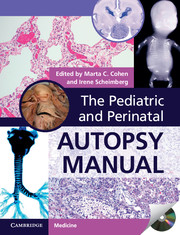Book contents
- Frontmatter
- Contents
- List of contributors
- Foreword
- Preface
- Acknowledgments
- 1 Perinatal autopsy, techniques, and classifications
- 2 Placental examination
- 3 The fetus less than 15 weeks gestation
- 4 Stillbirth and intrauterine growth restriction
- 5 Hydrops fetalis
- 6 Pathology of twinning and higher multiple pregnancy
- 7 Is this a syndrome? Patterns in genetic conditions
- 8 The metabolic disease autopsy
- 9 The abnormal heart
- 10 Central nervous system
- 11 Significant congenital abnormalities of the respiratory, digestive, and renal systems
- 12 Skeletal dysplasias
- 13 Congenital tumors
- 14 Complications of prematurity
- 15 Intrapartum and neonatal death
- 16 Sudden unexpected death in infancy
- 17 Infections and malnutrition
- 18 Role of MRI and radiology in post mortems
- 19 The forensic post mortem
- 20 Appendix tables
- Index
- References
5 - Hydrops fetalis
Published online by Cambridge University Press: 05 September 2014
- Frontmatter
- Contents
- List of contributors
- Foreword
- Preface
- Acknowledgments
- 1 Perinatal autopsy, techniques, and classifications
- 2 Placental examination
- 3 The fetus less than 15 weeks gestation
- 4 Stillbirth and intrauterine growth restriction
- 5 Hydrops fetalis
- 6 Pathology of twinning and higher multiple pregnancy
- 7 Is this a syndrome? Patterns in genetic conditions
- 8 The metabolic disease autopsy
- 9 The abnormal heart
- 10 Central nervous system
- 11 Significant congenital abnormalities of the respiratory, digestive, and renal systems
- 12 Skeletal dysplasias
- 13 Congenital tumors
- 14 Complications of prematurity
- 15 Intrapartum and neonatal death
- 16 Sudden unexpected death in infancy
- 17 Infections and malnutrition
- 18 Role of MRI and radiology in post mortems
- 19 The forensic post mortem
- 20 Appendix tables
- Index
- References
Summary
Introduction
Hydrops fetalis (HF) literally means “an abundance of water”; hydrops is similar to “the dropsy” from which patients with congestive cardiac failure used to suffer. HF fetuses have accumulations of fluid in pleural, pericardial, and peritoneal cavities, as well as subcutaneously. The majority of cases of HF are detected by antenatal ultrasound. There are many individual diseases that result in HF, and these disorders can be categorized in five main groups (Figure 5.1):
(1) cardiac failure (structural and functional)
(2) lymphatic system obstruction/malformation (dysplasia)
(3) thoracic cavity space occupation with increased pressure
(4) abdominal cavity space occupation with increased pressure
(5) fetal hypokinesia.
Underlying these categories may be chromosome abnormalities, single gene disorders, and infections. Currently, Online Mendelian Inheritance in Man lists 116 mutated single genes and their corresponding single gene disorders that are associated with HF; Google Scholar currently lists almost 17 000 published papers on hydrops fetalis, many of which were written in 1980–2010. At first the interlocking causes of HF may seem overwhelmingly complex, but placing them in the main groups described above and establishing chains of causation can simplify them. Major blood group alloimmunization was previously a frequent cause of HF in populations with, for instance, a prevalence of Rhesus D antigen incompatibility, but this is no longer the case, and other causes of (non-immunologic) HF are much more common. Primary fetal hypoproteinemia is not involved widely in HF; for instance, Finnish nephrosis and analbuminemia rarely, if ever, present clinically with HF. It is not always obvious how an underlying metabolic genetic disease (e.g., a storage disorder) causes HF, but hepatic involvement may result in reduced albumin synthesis (see below) and there may also be cardiomyopathy. In addition, large amounts of plasma proteins are sequestered in the third space of HF cases.
- Type
- Chapter
- Information
- The Pediatric and Perinatal Autopsy Manual , pp. 83 - 92Publisher: Cambridge University PressPrint publication year: 2000



